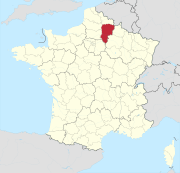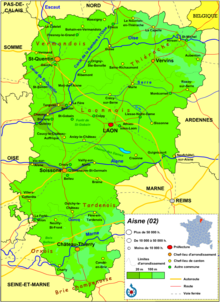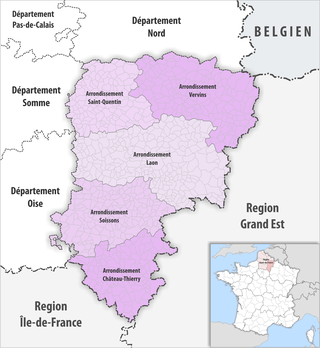Aisne department
| Aisne | |
|---|---|
| region | Hauts-de-France |
| prefecture | Laon |
| Sub-prefecture (s) |
Château-Thierry Saint-Quentin Soissons Vervins |
| Residents | 534,490 (Jan. 1, 2017) |
| Population density | 73 inhabitants per km² |
| surface | 7,362.20 km² |
| Arrondissements | 5 |
| Community associations | 20th |
| Cantons | 21st |
| Communities | 800 |
|
President of the Department Council |
Nicolas Fricoteaux ( UDI ) |
| ISO-3166-2 code | FR-02 |
 Location of the department of Aisne in the region of Hauts-de-France |
|
The Aisne [ ɛn ] is the French department with the atomic number 02. It is in the north of the country in the region Hauts-de-France and is named after the river Aisne named.
geography
The department is bordered by the North department to the north, Belgium to the northeast, the Ardennes and Marne departments to the east, the Seine-et-Marne department to the south and the Oise and Somme departments to the west .
Important rivers in the department are Aisne , Marne , Ourcq , Vesle , Somme , Oise , Serre .
coat of arms
Description: Divided into blue and gold by white wavy bars are three blue diagonal bars at the top and a white bar with a golden meander on both sides below .
history
The Aisne department is one of the 83 departments that were formed on March 4, 1790 during the French Revolution . It was combined from areas of the Île-de-France ( Laonnois , Soissonnais , Noyonnais , Valois ), Picardy ( Thiérache , Vermandois ) and Champagne . All incorporations are grouped under municipal mergers in the Aisne department .
During the First World War (1914–1918) there were three major fighting on the Aisne River:
On May 15, 1940, Wehrmacht troops invaded the Aisne department. They had started the campaign in the west five days earlier . They reached Montcornet on the evening of May 15th . From May 17th to June 10th, Wehrmacht units and units of the French army fought against each other in the 'Bataille de l'Aisne'; the Wehrmacht won the battle and a few days later occupied Paris without a fight. In Montcornet, Colonel Charles de Gaulle led one of the four counter offensives in the western campaign on May 17, 1940.
From 1960 to 2015, the department was part of the Picardy region , which in 2016 became part of the Hauts-de-France region.
population
The inhabitants of the Aisne department are called Axonais .
Demographics
The Aisne department contains several towns of medium importance, surrounded by numerous, but often very small, towns. The department lost part of its population in the second half of the 19th century due to rural exodus , which was partially compensated for by industrial development. Particularly affected in both world wars , the department then almost regained its population of 1900. For about 30 years, industrial decline has caused stagnation in the number of residents. Only the south still shows demographic growth due to its proximity to the agglomeration of Paris.
Cities
The most populous municipalities in the Aisne department are:
| city | Population (2017) |
Arrondissement |
|---|---|---|
| Saint-Quentin | 53,816 | Saint-Quentin |
| Soissons | 28,530 | Soissons |
| Laon | 24,876 | Laon |
| Château-Thierry | 15,107 | Château-Thierry |
| Tergnier | 13,456 | Laon |
| Chauny | 11,878 | Laon |
| Villers-Cotterêts | 10,872 | Soissons |
| Hirson | 8,813 | Vervins |
| Bohain-en-Vermandois | 5,664 | Saint-Quentin |
| Gauchy | 5,276 | Saint-Quentin |
Administrative division
The Aisne department is divided into 5 arrondissements , 21 cantons and 800 communes :
| Arrondissement | Cantons | Communities | Residents January 1, 2017 |
Area km² |
Density of population / km² |
Code INSEE |
|---|---|---|---|---|---|---|
| Château-Thierry | 4th | 108 | 70,059 | 1,115.15 | 63 | 021 |
| Laon | 7th | 240 | 156,706 | 2,176.05 | 72 | 022 |
| Saint-Quentin | 5 | 126 | 128.154 | 1,071.17 | 120 | 023 |
| Soissons | 5 | 166 | 107.930 | 1,342.05 | 80 | 024 |
| Vervins | 4th | 160 | 71,641 | 1,657.78 | 43 | 025 |
| Aisne department | 21st | 800 | 534.490 | 7,362.20 | 73 | 02 |
See also:
- List of communes in the Aisne department
- List of cantons in the Aisne department
- List of associations of municipalities in the Aisne department
Attractions
Like the entire former region of Picardy, the Aisne department is not very well developed for tourism. There are four areas worth noting when visiting the Aisne department:
As in all of eastern France, there are a large number of buildings from the early and high Gothic . The cathedrals in Laon , Soissons and Saint-Quentin should be mentioned in particular .
In addition, a number of well-known artists have close ties to the south of the department. The fable poet Jean de la Fontaine was born in Château-Thierry. The playwright Jean Racine in La Ferté-Milon . The novelist Alexandre Dumas the Elder comes from Villers-Cotterêts. The sculptor and painter Camille Claudel , wife of Auguste Rodin , comes from Fère-en-Tardenois .
In the north-eastern region of the Thiérache , many church buildings were converted into fortified churches , especially during the Eighty Years' War , which are characterized by reinforced walls, towers or intermediate floors as escape options. Examples are the churches in Englancourt or Archon .
Regarding recent history, the battlefields of the First World War are particularly worth seeing. In 2017, the département commemorated the battle of the Aisne 100 years ago , better known there as the Battle of the Chemin des Dames . The center of remembrance is the Drachenhöhle , a former quarry developed by the Reichswehr . In the cave, daily life in war and its hardships is depicted very vividly.
Web links
- Aisne department (French)
- Prefecture of the Aisne department (French)
Individual evidence
- ↑ aisne.com ( Memento of the original from July 1, 2012 in the Internet Archive ) Info: The archive link was inserted automatically and has not yet been checked. Please check the original and archive link according to the instructions and then remove this notice. Retrieved April 27, 2015
- ↑ INSEE Première N ° 1510, Les dépenses des touristes en France (from July 24, 2014 in French, PDF, 1 MB)
Coordinates: 49 ° 34 ' N , 3 ° 37' E




